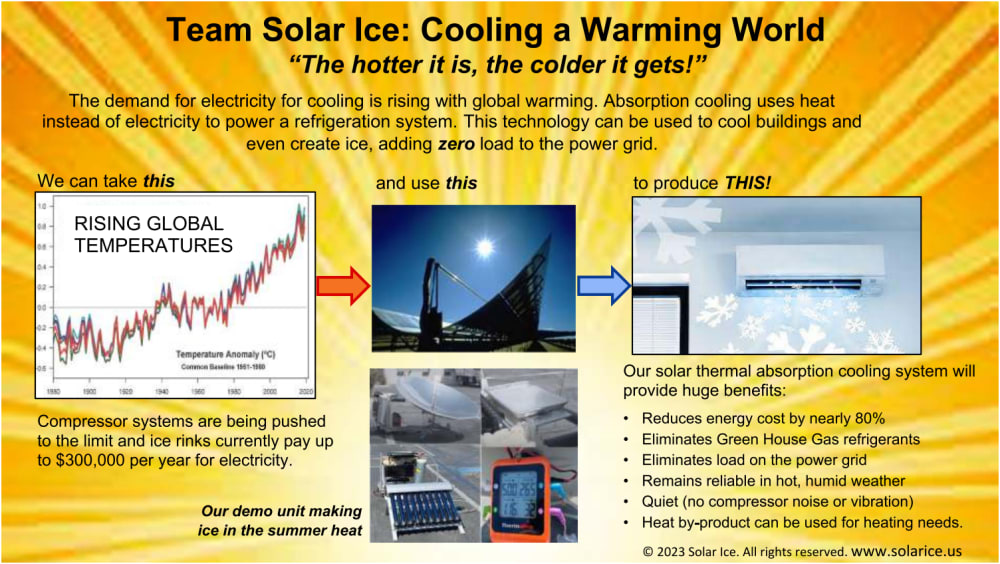
Our solar thermal absorption cooling system is an innovative, eco-friendly and low-cost solution that uses the sun's heat to cool buildings and provide domestic hot water, offering enhanced efficiency in hotter weather and catering to the needs of disadvantaged and low-income communities for a more equitable and sustainable future.
The solar thermal absorption cooling system consists of three major subsystems: (1) the thermal solar collector, (2) the absorption chiller, and (3) PCM thermal storage. Thanks to current technological advances in all three of these key components, we have now achieved the level of capability that enables us to build a profitable, commercially viable solar thermal absorption cooling system. While there have been solar-powered absorption coolers in the past, the inefficiencies, high cost and lack of modern PCM thermal storage limited their adoption in commercial and consumer applications. We are developing a highly efficient, eco-friendly and cost-effective solar thermal absorption cooling system that becomes more powerful as temperatures rise. Achieving this goal will mean reducing the burden on the power grid while providing an eco-friendly, cooling system suitable for widespread commercial and residential use at a hardware cost below conventional AC systems and operational costs of less than $0.10 per hour.
The three major subsystems are:
Thermal solar collectors: Our non-imaging concentrated solar collectors are a key component of our innovative solar thermal absorption cooling system. These specialized collectors’ harness and concentrate solar energy to produce high-temperature thermal energy without the need for tracking mechanisms. By utilizing non-imaging designs, these collectors can achieve cost-effective and efficient performance.
Absorption chiller: Modern developments in absorption chiller technology have resulted in more efficient, adaptable and scalable designs. These chillers have achieved efficiencies that can now effectively utilize the thermal energy provided by the concentrated solar collectors, eliminating the need for a compressor and offering significant energy savings.
The absorption chiller cycle requires the elimination of waste heat, which is achieved by the use of cooling coils. In our design, we will use this normally wasted by-product to heat domestic hot water. Not only will we cool a home or commercial building for almost no operating cost, but we will save the rate-payer the utility costs associated with water heating.
Because of the efficiency of our solar thermal collectors and absorption chillers, we expect to have a surplus of heated transfer fluid, that will be diverted our Phase Change Material storage system.
PCM thermal storage:
Phase change material thermal storage will be the main focus of our R&D work, as we have already identified viable designs for the solar collectors and absorption chillers. By concentrating our research efforts on optimizing and integrating advanced PCM materials into our system, we’ll revolutionize thermal energy storage and further enhance the efficiency and effectiveness of the solar thermal absorption cooling process. By doing so, we can provide continuous cooling during non-daylight hours or cloudy conditions, ultimately increasing the overall efficiency of the system and making it a more attractive, sustainable cooling solution for a wide range of applications.
-
Awards
-
 2023 Top 100 Entries
2023 Top 100 Entries
Like this entry?
-
About the Entrant
- Name:Steven Goldstein
- Type of entry:individual
- Software used for this entry:Solidworks, Co








